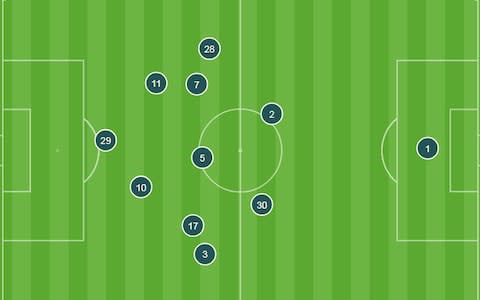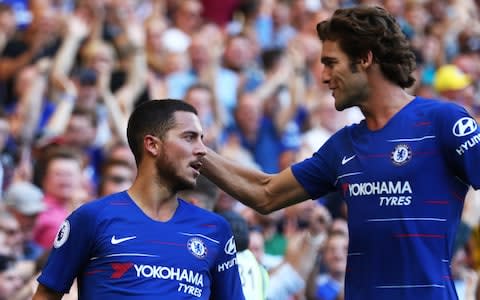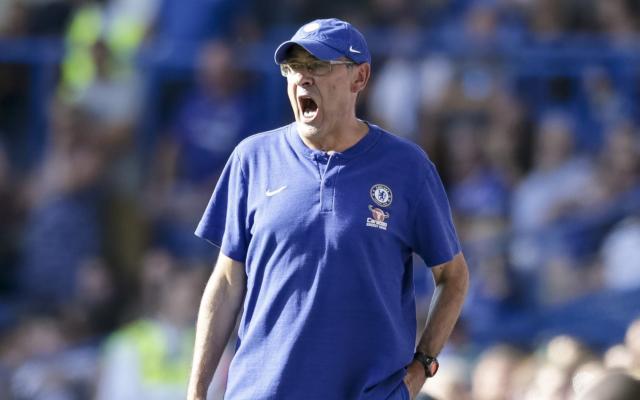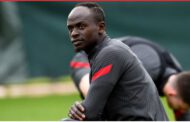In his ill-fitting t-shirt and cap-and-glasses combo, Maurizio Sarri looks more apathetic student than the stringent, methodical manager he is, but his image should not change perceptions of the work he has done and his impact already at Chelsea.
The new man in charge at Stamford Bridge promotes a very specific playing style that, as Bournemouth manager Eddie Howe observed this weekend, is “totally different” to that of his predecessor Antonio Conte.
We are only four league matches into the ‘Sarriball’ era, but there has nonetheless been a noticeable difference in the football at Stamford Bridge.
Sarri’s footballing philosophy, generally-speaking, asks for a attacking, progressive style of play from his players than Conte’s more defensive-minded, reactive tactics.
The vulnerability Chelsea have shown to the counter-attack already this season would never have been seen in the Conte era. Or if it had Conte would have been doing something like this on the touchline:

That vulnerability was exposed by Arsenal, only for a shedload of clear-cut chances that Pierre-Emerick Aubameyang and co. missed to ensure Chelsea held on to their lead, while Bournemouth were pretty unfortunate that they came away from Stamford Bridge with nothing, having missed a few decent chances on the break.
Improvements are certainly needed in that regard: better teams will punish them and on another day Arsenal or Bournemouth might well have done, but these are consequences of The Sarri Way that the former Napoli manager won’t be too concerned about.
In an attacking sense, his players are already doing much of what he asks. There is more possession than last season (though that number will surely drop from its current heights at almost 70 per cent as we get further into the season), and also a much higher defensive line.
Compare the average positions of Chelsea’s players away to Newcastle on the final day of last season…

…to the average position of their players in the corresponding fixture this season, played last month.

There is clearly a much higher defensive line under Sarri. The aim is to ensure there is less space for the opposition to play out, thereby increasing the chances of Chelsea’s press resulting in a turnover in an attacking position.
The problem is that one measured direct pass from an opponent can split the team and instantly turn Chelsea’s attack into a worrying counter.
When they have the ball, passes tend to be patient at the back, with the aim to get summer signing Jorginho on the ball early on in every move. The deep-lying playmaker has had 58 more touches of the ball this season than any other player in the Premier League.
The instruction for Jorginho – or a centre-back if Jorginho is marked and there is space elsewhere – is a fast, early vertical pass (towards goal) to try and gain ground as swiftly as possible. Quick movement and slick passing between the forward players is then the route to goal: see Pedro’s opener against Bournemouth on Saturday.
Chelsea spend less time defending under Sarri, and so there is no need for N’Golo Kante as a ball-winner at the base of midfield. He is now playing ahead of Jorginho, and so is needed to sweep up and win the ball far less frequently. He is making 2.5 tackles per game compared to 3.7 last season, one interception per game compared to 2.5 last season and one foul per game compared to 1.2. Chelsea’s tackles and interceptions are at their lowest rate in more than a decade.
Their domination of possession also means far fewer chances are made on the counter-attack than under Conte. They have had only one in four games under Sarri so far.
As there was in his time at Napoli, there is a focus on attacking down the left flank that should suit Eden Hazard.
Napoli had 46 per cent of their attacking touches of the ball on the left wing last season, which was more than any other team in Serie A. Chelsea’s left-sided attacks have gone up from 32 per cent – the lowest in the Premier League last season – to 39 per cent under Sarri.

The result has been two goals in two starts and two assists in two substitute appearances for Hazard, as well as a goal and two assists (and more shots than any other Chelsea player under Sarri) for left-back Marcos Alonso, who has been encouraged to get forward at every opportunity despite – nominally at least – playing in a deeper position than he did under Conte. He has been remarkably effective from left-back.
This attack-minded attitude has drawn criticism from some quarters, primarily due to how open Chelsea have looked on the counter.
But it is worth remembering how early a stage we are at in Sarri’s project. He will work on the training ground to keep impriving this team.
“I’m a coach. Give me a group of players and I will coach them,” he said earlier this year.
It’s already clear that his coaching is having a profound effect on the Chelsea team.












